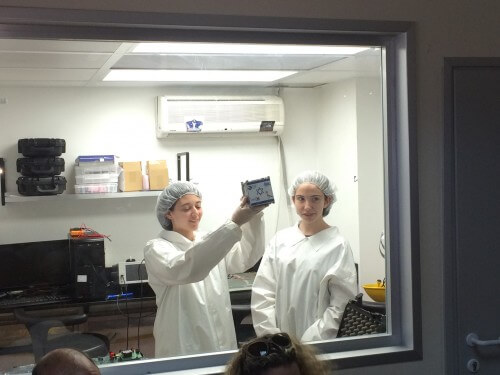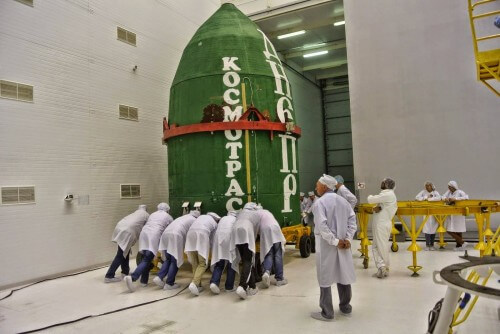Ten years passed from the day the project was decided to its completion, when dozens of high school students worked on its construction and carried out complex engineering projects. The satellite passed space readiness tests in the aerospace industry

For the first time in Israel and Europe, and only the second time in the world, today (June 19) in the evening, "Dokifat 1" - a nanosatellite, the result of research and development by high school students from the Herzliya Science Center, will be launched into space as part of an innovative project of the Israel Space Agency at the Ministry of Science and the Municipality of Herzliya. "Dokifat 1" is also the first tiny satellite launched by Israel into space.
According to the mayor of Herzliya, Moshe Padlon, students from three research and development centers in the Negev also participated in the project - students from Amal-1 school in Ofakim, a group of religious girls from Roham and a group of gifted Bedouin children from around the Negev. "When you see the excitement of the Herzlin boy and the 15-year-old Bedouin girl who aspires to reach Hal, there is not an eye that can remain dry," he said.
The satellite is one of many dozens of satellites ranging in size from 10x10 to 10x30 - or nanosatellites, which have already been installed on the third stage of the Dnieper missile from an underground bunker at the Yansi launch facility on the Russia-Kazakhstan border. However it is the only one built by students, the others were built by students at technological universities around the world.
"Dokifat 1" is built in the shape of a cube, each side of which is only ten centimeters long, weighing less than one kilogram. This nano-satellite precedes in its launch a number of tiny satellites that are currently being built in academia and in Israeli industry and is unique in that it was built entirely by students. Being groundbreaking, the project was supported by the Israel Space Agency in the Ministry of Science. About six months ago, a student satellite from the USA was launched into space with the support of NASA and the US space industry, while the Israeli satellite will be the second student satellite in the world to be launched into space.
At an event held this morning at the Science Center in Herzliya, Minister of Science, Technology and Space Yaakov Perry said: "Today's launch marks the beginning of the era of tiny satellites in Israel. The nano-satellites provide and will provide an answer to a large variety of civilian needs for the use of space in their development and which are relatively inexpensive compared to standard satellite launches. The field of space that was accessible to governments, empires, countries with great power is becoming almost the common property, descending to the ground and with the help of nano satellites like yours, we will make the technologies accessible to research institutions, universities and, as we see today, also schools."
Minister Perry also said: "The Ministry of Science undertakes education initiatives from kindergarten to universities, but this project is an example of innovative thinking and creativity of youth in Israel.

The vision for building the tiny satellite began about a decade ago with Dr. Anna Heller, a teacher at the Herzliya Science Center and director of the center's space laboratory. Over the years, more than 200 students participated in research and development, when in the last year the development process was accelerated and a group of about 40 children aged 17-16 worked around the clock to complete the satellite as part of a scientific-engineering project submitted for matriculation. The students were guided by a dedicated team of space engineers from the aerospace industry and the high-tech industry, led by Dr. Heller and Dr. Meir Ariel, director of the Science Center in Herzliya.
The satellite was built in a "clean room" installed for this purpose in the space laboratory at the Science Center. With the completion of the construction and functional tests about two months ago, the satellite was transferred to the aerospace industry facilities for a series of stringent tests of resistance to the hostile conditions prevailing in space. After successfully passing these tests as well, "Dokifat 1" was sent in a sealed and special suitcase to the launch base in Russia for its installation on the launch vehicle. The students say that in order for the valuable cargo not to attract attention, the suitcase was disguised inside an innocent cardboard box to look like computer mice that they found in the recycling bin. At the same time, the students were trained and gained a lot of experience in communicating on amateur radio frequencies with civilian satellites, using the ground station for satellite communication and radio amateurs that was also built at the Herzliya Science Center.
The size of the satellite - 10 * 10 * 10 cm - and its weight - only 860 grams - are also its advantage. "The weight and tiny size of the satellite make it cheaper to develop and launch, compared to the usual satellites that weigh hundreds of kilograms and require much more energy and millions of dollars to launch and operate them in space" explains the director of the Israel Space Agency in the Ministry of Science Menachem Kidron.
The satellite will help travelers who get lost in a place where there is no cellular reception. The lost hiker will be able to send distress signals from an amateur walkie-talkie to the nano-satellite, which in turn will transmit to the control center in Herzliya, locate the hiker's location and send a rescue force. Since about 90% of the Earth's surface is covered by oceans, deserts, rainforests and glaciers, these are huge areas where there is no cellular reception.
The satellite contains a command system, an energy control system, a sophisticated communication system as well as batteries to operate the satellite for the times when it stays in the part of the orbit hidden from the sun. The satellite is covered with solar panels that are resistant to the extreme space environment. Some of the satellite components can even be bought directly online today, but their price may reach tens of thousands of dollars per component.
"The project expands the scientific boundaries that teenagers engage in to a new level and along the way can also save lives," says Shenhav Lizarovich, now a 19-year-old Atudaite who was a student at the Satellite and Space Laboratory for four years. "The practical studies permeated our consciousness and introduced us to an overall enthusiasm for the world of space."
The satellite will be launched today, June 19, at 22:10 Israel time from the Yaseni launch base in Russia. The "Dnieper" launch vehicle that will carry "Dokifat 1" into space is a former military cruise missile that has been converted for civilian use. The missile is 34 meters long and weighs 211 tons at takeoff. A few hours after the launch, the students will try to communicate for the first time with the satellite, which will then be at an altitude of 600 km above the earth and will move at a speed of about 27,000 km/h, and receive a first status report from it. The satellite will be launched together with satellites from Denmark, the Netherlands, the USA, Argentina, Belgium, Brazil, Singapore and Ukraine. Dr. Anna Heller and four of the students who led the project will be present at the launch in Iasi.
As mentioned, the satellite will circle at an altitude of 600 km and every hour and a half it will completely circle the earth. At any given moment, the satellite will be able to receive distress signals from a surface with a diameter of about 4,000 km, so that it will actually cover the entire planet in a few hours. There is currently no satellite in space that provides a broad response on such a scale. The satellite is driven by the force of the initial speed it will gain during launch, does not contain a fuel cell and will remain in orbit in space for about 20 years, of which the students hope it will function properly for about two years.
With the successful completion of this project, the Herzliya Science Center now began work on "Dukhipat 2" - also a tiny satellite, but twice as large as its elder brother - "Dukhipat 1" and even more sophisticated. "Dukifat 2" will also be built by students as part of a national educational project with the participation of schools from around the country, including from the Negev. "Dokifat 2" is a scientific satellite designed for the exploration of the near future space that will be launched in about two years along with 50 other tiny satellites as part of a global project initiated by the European Space Agency called "Cube 50". As part of the European project, teams of students from 27 countries are building 50 tiny satellites that carry instruments for performing measurements and experiments in space. The 50 satellites will be launched "as a swarm of satellites" at the same time in a single launch. Such a wide network of satellites will allow scientists to get an accurate picture of the lower thermosphere - a region of the atmosphere with very strong ultraviolet radiation that has not yet been explored. The young Israeli team is the only one among the teams that are members of the prestigious project made up of high school students. The other groups are groups of graduate scientists and engineering students.
"The Dokifat 1 and Dokifat 2 projects are the cutting edge of scientific education in Israel and the upcoming launch is proof of the success of the city's multiple investment in the youth" proudly said Moshe Padlon, mayor of Herzliya.
Padlon used the opportunity to announce the establishment of a science center where all Herzliya students - from kindergarten to XNUMXth grade - will come for a day of the week where they will conduct experiments and research.

5 תגובות
Idan
safe trip. May there be many like you. Bless you
By the way, I'm a girl
I really liked the idea and I also really want to participate in such a project.
I really liked the initiative of the teachers and the children, I hope to also participate in this type of project.
All the best to the students of Herzliya School of Engineering (formerly Ramat Aviv School of Engineering)